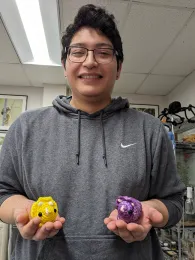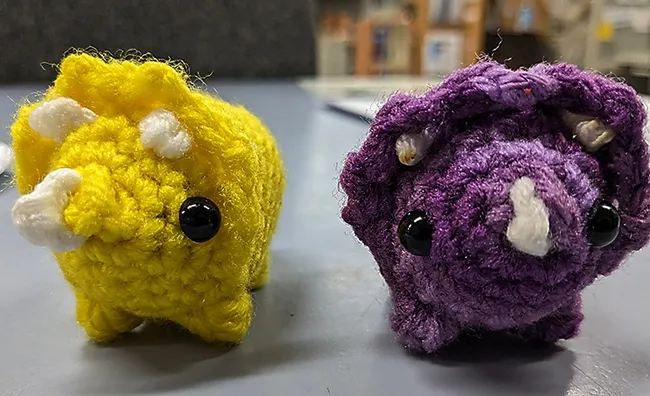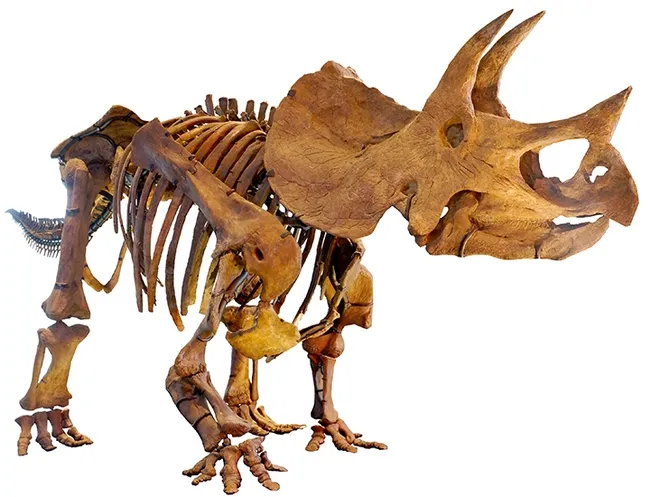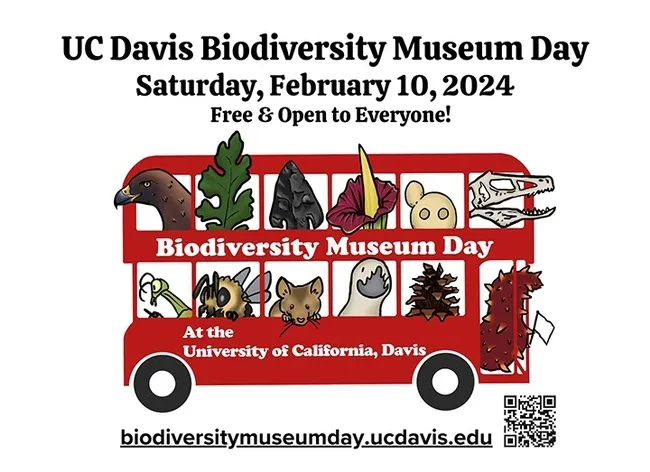
And who especially loves triceratops, the dinosaur with that three-horned face that lived 66 to 68 million years ago in North America? Measuring about 26 to 30 feet long, it weighed 5.5–9.9 short tons, according to Wikipedia. "It shared the landscape with and was most likely preyed upon by Tyrannosaurus, though it is less certain that two adults would battle in the fanciful manner often depicted in museum displays and popular media."
If you attend the 13th annual UC Davis Biodiversity Museum Day, a free and family friendly "Super Science Day" on Saturday, Feb. 10, showcasing 10 museums and collections, keep your eyes open for crocheted triceratops. The treasures will be hidden around some of the buildings, including the Earth and Physical Sciences Building, home of the Paleontology Collection.
They're the work of Jakob Lopez, a third-year animal biology major at UC Davis and an intern at the Bohart Museum of Entomology. How his eyes lit up when he saw the triceratops riding the double-decker bus, a Biodiversity Museum Day graphic.
"I am going to make around 15-20, most likely," he said. An attached note will read: "CONGRATS, you found me. Now please take care of me.--Happy Biodiversity Day 2024."
The story behind the story?
Jakob has interned at the Bohart Museum since the beginning of the winter quarter. "I plan on using my time at the Bohart wisely and I eventually would like to spread awareness of using bugs as a food source/enhancer. I also would also like to be involved in using art to depict science. For example I would like to come out with my own book of scientific illustrations."
The 10 museums or collections participating on Feb. 10 and the hours open are:
- Anthropology Museum, 328 Young Hall and grounds, open from noon to 4 p.m.
- Arboretum and Public Garden, Habitat Gardens in the Environmental GATEway, adjacent to the Arboretum Teaching Nursery on Garrod Drive, 10 a.m. to 2 p.m.
- Bohart Museum of Entomology, Room 1124 and main hall of the Academic Surge Building, 455 Crocker Lane, 10 a.m. to 2 p.m.
- Botanical Conservatory, the greenhouses along Kleiber Hall Drive, 10 a.m. to 2 p.m.
- California Raptor Center, 1340 Equine Lane, off Old Davis Road, 9 a.m. to 3 p.m.
- Center for Plant Diversity, Katherine Esau Science Hall off Kleiber Hall Drive, 10 a.m. to 2 p.m.
- Nematode Collection (part of the UC Davis Department of Entomology and Nematology), Katherine Esau Science Hall, off Kleiber Hall Drive, 10 am. to 2 p.m.
- Museum of Wildlife and Fish Biology, Room 1394, Academic Surge Building, 455 Crocker Lane, 10 a.m. to 2 p.m.
- Paleontology Collection, Department of Earth and Planetary Sciences, 1309 Earth and Physical Sciences Building, 434 LaRue Road, 10 a.m. to 2 p.m.
- Phaff Yeast Culture Collection, Robert Mondavi Institute Brewery and Food Processing facility, Old Davis Road, 10 a.m. to 2 p.m.
The double-decker bus is the 2020 work of Ivana Li, UC Davis biology laboratory manager. It was colorized and updated this year by Caitlen Comendant, an undergraduate design major at UC Davis, and a media intern for the Center for Plant Diversity and the Botanical Conservatory.
Sharing the bus on the upper level are (from left)
- California Raptor Center: Golden eagle
- UC Davis Arboretum and Public Garden: Valley oak leaf
- Anthropology Museum: Projectile point
- Botanical Conservatory: Titan arum
- Phaff Yeast Collection: Budding yeast
- Paleontology Collection: Skull of Triceratops
Lower level (from left)
- Bohart Museum of Entomology: Chinese praying mantis, Tenodera sinensis
- UC Davis Bee Haven: honey bee
- Museum of Wildlife and Fish Biology: Salt marsh harvest mouse
- Nematode Collection: Hookworm
- Center for Plant Diversity: Seed cone of a gray pine
- Marine Invertebrates Collection: California sea cucumber (included on bus but this collection will not be included at the Biodiversity Museum Day)
Last year some 4,000 visitors learned "about biodiversity through our amazing biological collections," said Yang, co-founder of the event. It's an opportunity to talk to the scientists and learn about the work they're doing.




